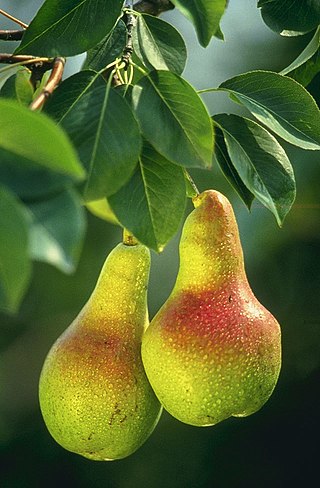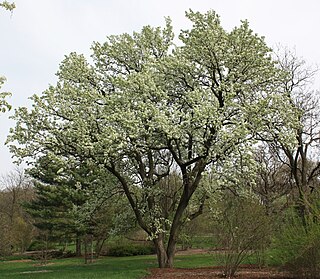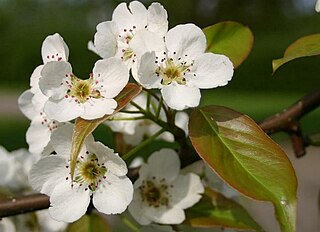
Pears are fruits produced and consumed around the world, growing on a tree and harvested in late summer into mid-autumn. The pear tree and shrub are a species of genus Pyrus, in the family Rosaceae, bearing the pomaceous fruit of the same name. Several species of pears are valued for their edible fruit and juices, while others are cultivated as trees.

In biology, a hybrid is the offspring resulting from combining the qualities of two organisms of different varieties, species or genera through sexual reproduction. Generally, it means that each cell has genetic material from two different organisms, whereas an individual where some cells are derived from a different organism is called a chimera. Hybrids are not always intermediates between their parents, but can show hybrid vigor, sometimes growing larger or taller than either parent. The concept of a hybrid is interpreted differently in animal and plant breeding, where there is interest in the individual parentage. In genetics, attention is focused on the numbers of chromosomes. In taxonomy, a key question is how closely related the parent species are.

The MaloideaeC.Weber was the apple subfamily, a grouping used by some taxonomists within the rose family, Rosaceae. Recent molecular phylogenetic evidence has shown that the traditional Spiraeoideae and Amygdaloideae form part of the same clade as the traditional Maloideae, and the correct name for this group is Amygdaloideae. Earlier circumscriptions of Maloideae are more-or-less equivalent to subtribe Malinae or to tribe Maleae. The group includes a number of plants bearing commercially important fruits, such as apples and pears, while others are cultivated as ornamentals.

Pyrus pyrifolia is a species of pear tree native to southern China and northern Indochina, and have been introduced to Korea, Japan and other parts of the world. The tree's edible fruit is known by many names, including Asian pear, Persian pear, Japanese pear, Chinese pear, Korean pear, Taiwanese pear, apple pear, zodiac pear, three-halves pear, papple, naspati and sand pear. Along with cultivars of P. × bretschneideri and P. ussuriensis, the fruit is also called the nashi pear. Cultivars derived from Pyrus pyrifolia are grown throughout East Asia, and in other countries such as India, Pakistan, Nepal, Australia, New Zealand, and the United States. Traditionally in East Asia the tree's flowers are a popular symbol of early spring, and it is a common sight in gardens and the countryside.

Pyrus × bretschneideri, the ya pear or pearple or Chinese white pear, is an interspecific hybrid species of pear native to North China, where it is widely grown for its edible fruit.
Heterosis, hybrid vigor, or outbreeding enhancement is the improved or increased function of any biological quality in a hybrid offspring. An offspring is heterotic if its traits are enhanced as a result of mixing the genetic contributions of its parents. The heterotic offspring often has traits that are more than the simple addition of the parents' traits, and can be explained by Mendelian or non-Mendelian inheritance. Typical heterotic/hybrid traits of interest in agriculture are higher yield, quicker maturity, stability, drought tolerance etc.

The trifoliate orange, Citrus trifoliata, is a member of the family Rutaceae. Whether the trifoliate oranges should be considered to belong to their own genus, Poncirus, or be included in the genus Citrus is debated. The species is unusual among citrus for having deciduous, compound leaves and pubescent (downy) fruit.

Pyrus calleryana, or the Callery pear, is a species of pear tree native to China and Vietnam, in the family Rosaceae. It is most commonly known for its cultivar 'Bradford' and its offensive odor, widely planted throughout the United States and increasingly regarded as an invasive species.

Pyrus communis, the common pear, is a species of pear native to central and eastern Europe, and western Asia.

Malus sieversii is a wild apple native to the mountains of Central Asia in southern Kazakhstan. It has recently been shown to be the primary ancestor of most cultivars of the domesticated apple. It was first described as Pyrus sieversii due to its similarities with pears in 1833 by Carl Friedrich von Ledebour, a German naturalist who saw them growing in the Altai Mountains.

Sweet lemon and sweet lime refer to groups of citrus hybrids that contain low acid pulp and juice. They are hybrids often similar to non-sweet lemons or limes, but with less citron parentage. Sweet limes and lemons are not sharply separated:
The sweet lime, Citrus limettioides Tan., is often confused with the sweet lemon, C. limetta Tan., which, in certain areas, is referred to as "sweet lime". In some of the literature, it is impossible to tell which fruit is under discussion.

Cornus officinalis, the Japanese cornel or Japanese cornelian cherry, is a species of flowering plant in the dogwood family Cornaceae. Despite its name, it is native to China and Korea as well as Japan. It is not to be confused with C. mas, which is also known as the Cornelian cherry. It is not closely related to the true cherries of the genus Prunus.

Tree peony is the vernacular name for the section Moutan of the plant genus Paeonia, or one of the species or cultivars belonging to this section. It consists of shrubs that have perennial aerial woody stems. Other peonies do not have perennial woody stems, but their stems die back after the growing season, to emerge again from buds just below the surface early in the following year. Tree peonies have been in culture in China for millennia, and it is likely that hybrids came into being in gardens, where different wild tree peony species were planted closely together. They are used in China both for medicine and as an ornamental, particularly the hybrids called Paeonia suffruticosa. These hybrids in particular, but other tree peonies too, are called mǔdān (牡丹) in China.

Dangshan County is a county in the far north of Anhui Province, China. It is under the administration of Suzhou city. It is famous for fruits.

The Maleae are the apple tribe in the rose family, Rosaceae. The group includes a number of plants bearing commercially important fruits, such as apples and pears, while others are cultivated as ornamentals. Older taxonomies separated some of this group as tribe Crataegeae, as the Cydonia group, or some genera were placed in family Quillajaceae.
Erwinia pyrifoliae is a Gram-negative bacterium and a phytopathogen of Asian pear trees, causing necrotic disease. Its type strain is Ep16/96T(=CFBP 4172T =DSM 12163T.

Pyrus ussuriensis, also known as the Ussurian pear, Harbin pear, and Manchurian pear, is a species of flowering plant in the family Rosaceae.
Pyrus phaeocarpa, the dusky pear or orange pear, is a species of flowering plant in the family Rosaceae, native to the Loess Plateau of northern China. A wide tree reaching at most 7–8 m (23–26 ft) in height, it is hardy to USDA zone 5, or perhaps even zone 4. Its small yellow to brown fruit are edible, and its Autumn foliage is bright orange to orange-red, giving it good potential as an ornamental. Its chloroplast genome shows that it is closely related to Pyrus pashia, the wild Himalayan pear, and it is suspected to be a hybrid of P. betulifolia, the birchleaf pear, P. pyrifolia, the apple pear, and P. ussuriensis, the Manchurian pear.
Pyrus hopeiensis is a species of wild pear in the family Rosaceae, native to north-central China. It is a naturally occurring hybrid of other Chinese Pyrus species, but is it unclear which ones are its parents. Its fruits are small and bitter, so it is not valued or conserved by locals.
Pyrus pseudopashia is a species of wild pear in the family Rosaceae, native to south-central China. As a crop wild relative of pears, it is in urgent need of conservation. Unfortunately all its accessions in the USDA-ARS National Pyrus Collection appear to have been misidentified or mislabeled.













